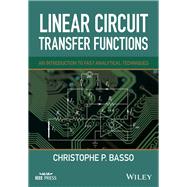Linear Circuit Transfer Functions: An introduction to Fast Analytical Techniques teaches readers how to determine transfer functions of linear passive and active circuits by applying Fast Analytical Circuits Techniques. Building on their existing knowledge of classical loop/nodal analysis, the book improves and expands their skills to unveil transfer functions in a swift and efficient manner.
Starting with simple examples, the author explains step-by-step how expressing circuits time constants in different configurations leads to writing transfer functions in a compact and insightful way. By learning how to organize numerators and denominators in the fastest possible way, readers will speed-up analysis and predict the frequency response of simple to complex circuits. In some cases, they will be able to derive the final expression by inspection, without writing a line of algebra.
Key features:
- Emphasizes analysis through employing time constant-based methods discussed in other text books but not widely used or explained.
- Develops current techniques on transfer functions, to fast analytical techniques leading to low-entropy transfer functions immediately exploitable for analysis purposes.
- Covers calculation techniques pertinent to different fields, electrical, electronics, signal processing etc.
- Describes how a technique is applied and demonstrates this through real design examples.
- All Mathcad® files used in examples and problems are freely available for download.
An ideal reference for electronics or electrical engineering professionals as well as BSEE and MSEE students, this book will help teach them how to: become skilled in the art of determining transfer function by using less algebra and obtaining results in a more effectual way; gain insight into a circuit’s operation by understanding how time constants rule dynamic responses; apply Fast Analytical Techniques to simple and complicated circuits, passive or active and be more efficient at solving problems.








